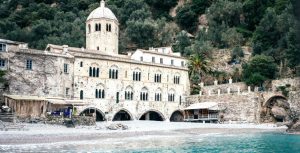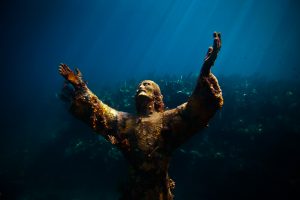There are still places in Italy where time stands still. One of them is the Abbey of San Fruttuoso di Camogli, on the Ligurian coast. The Abbey sits on a breathtakingly beautiful bay between the towns of Camogli and Portofino, and because it is only accessible by boat or via a foot path through the mountains, it has remained pretty much the same for centuries.
In addition to the Abbey and the church, there are three slightly ramshackle houses, a restaurant with a few rooms to rent if you want to stay overnight, and a 16th-century watchtower. While it may not look like much now, the truth is San Fruttuoso has had more lives than a cat. In different centuries it has been a Benedictine monastery, a pirates’ den, a humble fishing village and for a long time, the private property of the Doria Princes, a wealthy family from Genoa.
The problem with going back to the beginning when you are dealing with properties that are this old, is that the story tends to get a little muddled. This story is a good example. From what we know today, it seems the Abbey was first built by Greek monks sometime in the year 900. It was named after Bishop Fruttuoso, a Spanish martyr who was burned alive in the year 259. This was a period of severe conflict between the Roman Emperor Valerian and the Christians. It was known as the eighth persecution.
Bishop Fruttuoso’s ashes, and the ashes of two other martyrs who were burned to death at the same time, were transported to Liguria by another Spanish Bishop, San Prospero. Prospero had fled Spain in 711 after the invasion of Islamic forces from Morocco. Some stories claim an angel led him to San Fruttuoso, but however it happened, that’s where he ended up.
One of the first things San Prospero did was build a church. If you go to San Fruttuoso and walk the hill behind the Abbey, you will reach an area known as “Old Church” where you will see the ruins of an ancient building. It’s possible that they are the ruins of the church Prospero built a thousand years ago. No one really knows.

What did become apparent during a recent restoration of the complex, however, is that the part of the Abbey that dates from the 1200’s had been built on top of an older Romanesque structure. And given the practice of building and rebuilding on top of previous construction, it makes me wonder what they would have found if they had dug a little deeper.
What was found however, were a number of important artifacts, which document the history of the Abbey and the life of the monks who lived there. The artifacts are now on display in the small museum that was set up in the main body of the Abbey.
If you go through the lower level of the cloister you can access the deep, barrel-vaulted space that the monks used as a burial chamber. It’s not spooky like the Catacombs, it’s actually a lovely, open space. Members of the Doria family were also laid to rest here. Their tombs are decorated with alternating stripes of white marble from Carrara and black ardesia from nearby Lavagna. It is a design combination that was reserved for the church and very rich Ligurians, which qualified the Doria family, as they were the richest of the rich.
The 1500’s were a period of exploration. The opening of the New World had triggered many new industries, including shipping and trade. This was particularly true in Genoa. This meant there were large sailing ships laden with gold, spices and sometimes slaves docking daily at the Genoa port, and from there transported up and down the coast as well as inland. For the Barbary pirates who cruised the Mediterranean looking for ships to attack, this floating parade of merchandise was like honey to a bear.
But the one thing that those gold laden ships did not have, but was of intrinsic importance to the pirates, was fresh water. For fresh water they had to go to San Fruttuoso. To access that water, they first had to challenge the Doria. The Doria had built a watchtower in 1562, and so there would be no mistake as to who the water belonged to, they decorated the tower with their family coat-of-arms. Then they brought in paid mercenaries from their private army in Genoa and proceeded to defend the fresh water supply.
The Abbey of San Fruttuoso is one of the treasures of Liguria, it’s a spiritual place, and a lovely way to experience the peace and tranquility of a place where time stands still.
SIDEBAR
The Christ of the Abyss

The original statue of the Christ of the Abyss is in the waters just off the coast of San Fruttuoso. The bronze statue of Jesus with his arms raised upward is located about 50 feet (15 meters) under the sea and was placed there at the request of legendary Italian diver Duilio Marcante. He wanted it placed there in remembrance of his friend Dario Gonzatti, who died in that spot during a dive. The Christ of the Abyss has become a tourist destination for scuba divers around the world.
Phyllis Macchioni is a Italian American writer who lives on the Italian Riviera. She is the author of a recently released collection of essays entitled “This Italian Life – People and Places”, available on Amazon. Visit her blog at https:// www.thisitalianlife.blogspot.com or https:// www.facebook.com/ phyllis.macchioni
Email:phyllisinitaly@gm ail.com




























